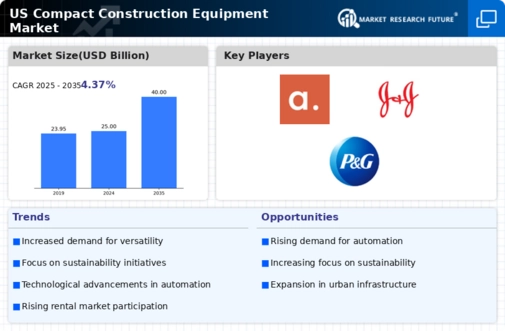Labor Shortages and Workforce Dynamics
Labor shortages in the construction industry are increasingly impacting the compact construction-equipment market. With a declining workforce, companies are turning to compact machinery to enhance productivity and compensate for the lack of skilled labor. The compact construction-equipment market is experiencing a shift as businesses invest in technology that allows for easier operation and reduced training time. Data suggests that the construction industry faces a shortage of approximately 400,000 workers, prompting firms to adopt compact equipment that can be operated by fewer personnel. This trend indicates a potential for growth in the compact construction-equipment market as companies seek to optimize their operations and maintain project timelines despite workforce challenges.
Technological Integration and Automation
The integration of advanced technologies and automation in the compact construction-equipment market is transforming operational efficiencies. Innovations such as telematics, GPS tracking, and automated controls are becoming standard features in compact machinery. These technologies enable operators to monitor equipment performance in real-time, leading to improved maintenance and reduced downtime. The compact construction-equipment market is witnessing a surge in demand for smart machinery that enhances productivity and reduces operational costs. As contractors increasingly adopt these technologies, the market is expected to expand, driven by the need for efficiency and data-driven decision-making in construction projects.
Government Regulations and Safety Standards
Government regulations and safety standards play a crucial role in shaping the compact construction-equipment market. Stricter safety regulations are driving manufacturers to innovate and produce equipment that meets these requirements. Compliance with safety standards not only ensures worker safety but also enhances the marketability of compact machinery. The compact construction-equipment market is likely to see increased demand for machines that incorporate advanced safety features, such as automatic shut-off systems and enhanced visibility. As regulations evolve, manufacturers are expected to invest in research and development to create compliant equipment, potentially leading to a more competitive market landscape.
Urbanization and Infrastructure Development
The ongoing trend of urbanization in the United States is a primary driver for the compact construction-equipment market. As cities expand and infrastructure projects increase, the demand for compact machinery rises. Urban areas require efficient construction solutions that can navigate tight spaces, making compact equipment essential. According to recent data, the construction sector is projected to grow at a CAGR of 4.5% through 2027, indicating a robust demand for compact machinery. This growth is fueled by public and private investments in infrastructure, including roads, bridges, and public transit systems. The compact construction-equipment market is likely to benefit significantly from these developments, as contractors seek versatile and efficient equipment to meet project demands.
Environmental Concerns and Emission Regulations
Environmental concerns and stringent emission regulations are significantly influencing the compact construction-equipment market. As awareness of climate change grows, there is a push for cleaner and more sustainable construction practices. The compact construction-equipment market is adapting to these demands by developing machines that comply with emission standards, such as Tier 4 regulations in the United States. This shift towards eco-friendly equipment is likely to attract environmentally conscious contractors and project owners. Furthermore, the market may see increased investment in electric and hybrid compact machinery, reflecting a broader trend towards sustainability in the construction industry.

















Leave a Comment